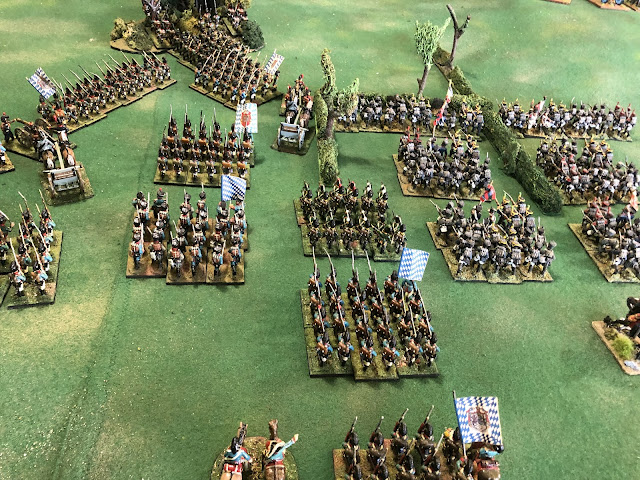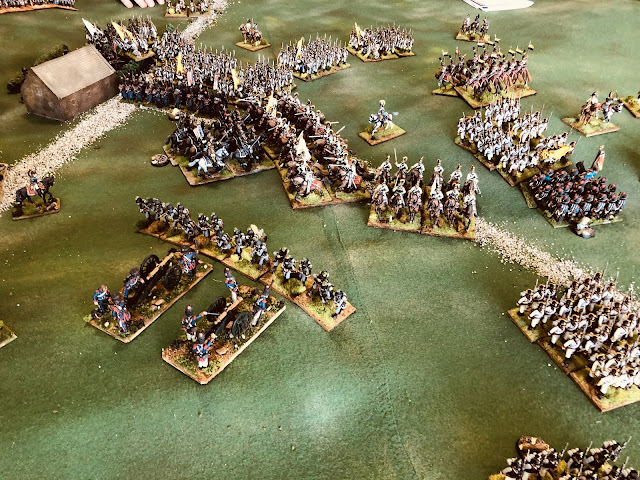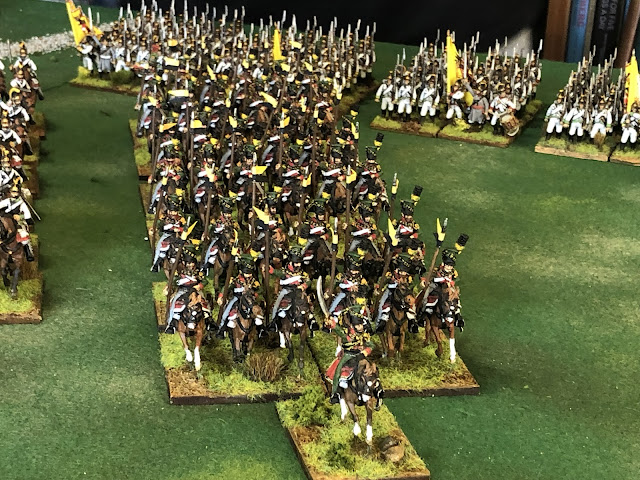Sunday's game (yes I know that was three days ago, but its been a busy three days), the last game for 2024, was a Napoleonic battle - a Franco-Bavarian force fighting a Austro-Prussian force involving seven players. The game has no specific scenario and the terrain was relatively neutral with some gentle hills, a couple of small farms and woods. It was really just an excuse for a game.
The Franco-Bavarian forces had a significantly large number of battalions, although the Austro-Prussian battalions were larger. Each commend had a basic force and in some cases could chose from one or two options.
The Forces
|
Franco-Bavarian Forces
|
Austro-Prussian forces
|
French command one
- 12 line infantry battalions
- 2 cavalry regiments
- 2 artillery batteries
- Option 1 - 3 artillery batteries...taken
- Option 2 - 3 cuirassier regiments
French command two - 12 line infantry battalions
- 2 cavalry regiments
- 2 artillery batteries
- Option 1 - 3 artillery batteries
- Option 2 - 4 dragoon regiments...taken
French command three - 6 Guard infantry battalions
- 2 Guard cavalry regiments
- 2 Guard artillery batteries
Bavarian command - 12 line infantry battalions
- 3 cavalry regiments
- 2 artillery batteries
- Option 1 - 3 artillery batteries...taken
- Option 2 - 3 cavalry regiments
|
Austrian command one - 12 line infantry battalions
- 3 cavalry regiments
- 2 artillery batteries
- Option 1 - 3 artillery batteries
- Option 2 - 3 uhlan regiments...taken
Austrian command two - 11 line infantry battalions
- 1 cavalry regiment
- 2 artillery batteries
- Option 1 - 3 artillery batteries...taken
- Option 2 - 3 cavalry regiments
Prussian command - 6 infantry battalions
- 2 line cavalry regiments
- 4 artillery batteries
- Option 1 - 3 artillery batteries
- Option 2 - 3 cavalry regiments...taken
- 6 battalions (4 landwehr, 2 line)
|
|
Total 42 battalions 13 cavalry regiments 14 artillery batteries.
|
Total 29 battalions 12 cavalry regiments 11 artillery batteries.
|
The Franco-Austrians deployed with French Command One on the tight. To their left was the Guard, then French Command Two. The line was closed out on the extreme left by the Bavarians. The Austro- Prussians formed with Austrian Command Two on the left, facing French Command One, with Austrian Command One next in line and with the Prussians holding the extreme right, opposite French Command Two and the Bavarians.
 |
| The Franco-Bavarians deploy |
The Austro-Prussian plan was to pin the French right, use a long ridge on the opposite end of the line to hide the weakness of the Prussian force and strike the French right-centre. Between the two armies on this part of the field stood a short ridge. Whoever took control of the crest, controlled the area. The Austrian cavalry massed in front, six regiments in all, backed up by eighteen battalions. The Austrians got initiative (first move) and three regiments of uhlans took the crest.
 |
| The Austrians on the left |
 |
| The uhlans take the ridge |
 |
| The French cavalry charged... |
 |
| The Austrians counter-charged, smashing the French... |
 |
| Then broke through on the supports... |
 |
| The French infantry scrambled to form squares... |
 |
While the uhlans disengaged the cuirassiers covered the advance of the infantry
|
Suddenly in three turns the French right-center was in turmoil.
Meanwhile to their left French Command Two and the Bavarians were bring held at bay by the Prussians. A mere six Prussian battalions, four batteries and some cavalry were holding back nearly three times their number. This they did by not exposing their infantry and playing a cat and mouse game with their cavalry. The French and Bavarians were holding back.
The Austrian infantry smashed into the guard.
The French dragoons from their left turned to the collapsing centre to try to stabilise the line, but they were met by the Austrian cuirassiers.
The French troopers were driven off and the jagers assaulted and routed the guard artillery.
The French centre continued to crumble and a huge hole opened up. The Franco-Bavarians conceded. It was an astonishing victory...and the first time that an Austrian led army had ever won on our tables. The Bavarians had not taken a single casualty; the Austrians on the left were only scratched, but the French defeat was clear.
It was an interesting game to dnd the year.
And now for a bunch of random pictures...

















































